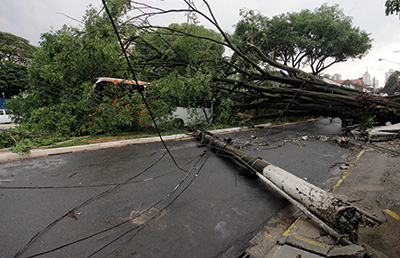The Sanlam Group is also involved in parametric insurance in Mali and Uganda, while Santam has successfully piloted a Soil Moisture Index product in collaboration with the South African Insurance Association (SAIA), the Financial Sector Conduct Authority (FSCA) and the Prudential Authority (PA). Following recent interactions between the FSCA, PA and SAIA it was agreed that additional parametric pilots would be permitted. Until then, the focus will be on traditional insurance solutions, advised on by skilled insurance brokers.
A greater proportion of medium and large businesses in the agriculture sector (80%) – compared to 70% across all sectors – preferred a broker to assist in navigating the complex Agri Crop insurance market. More than 90% of Santam’s Agri Crop policies are sold through a broker with only a handful of experienced farmers insuring directly.
From a crop insurance perspective, the broker gives advice on the type of cover to purchase, and the sum insured. Santam and its brokers are risk specialists who leave the day-to-day grind of ‘good and proper farming’ to the insured, who commits to ‘proper farming practices’ when they sign up for the Agri Crop insurance policy. Crop insurance is a sub-set of the total cover an agriculture business purchases. A comprehensive policy will include assets and all risks cover for buildings, equipment, machinery, and a range of commercial vehicles, among other covers. As such, agriculture businesses rely on brokers to advise them on risk exposures, risk mitigation and the optimal transfer of risks through an insurance policy.
Recruiting and retaining existing skilled talent is a challenge for insurers in this sector. The technical skills required for crop insurance underwriting, claims assessments, and data analyses is an important component of success. Santam runs a mentorship training programme to develop skills in this area. But to gain the level of expertise needed to evaluate and advise appropriately on risk exposures and cover requirements takes years as brokers only gain sufficient experience with various crops over multiple seasons.
The affordability of cover featured strongly in the 2020-2021 Insurance Barometer, and remains a concern in 2022-2023, with 58% of agriculture businesses indicating ‘value for money’ as an important factor when buying insurance. The price of crop insurance is driven by, amongst other factors, historical loss experiences, and the only way for an insurer to rein in costs is to reduce cover through higher policy excesses or excluding cover for specific perils. But failing to match premium to risk has dire consequences.
Farmers should carefully study their policy wordings to ensure they are getting the most comprehensive cover. For instance, some insurers only cover crops up to a certain stage of maturity, whereas Santam’s cover lasts until the crop is harvested. We settled several claims for loss or damage incurred due to late hail in April and May 2023 whereas some other farmers, not insured with us, found they were not covered.
Farmers, meanwhile, can take various steps to reduce the financial and insurable risk exposures of their businesses. Most farmers mitigate their crop-related risk by diversifying geographic exposures and income streams. Farmers who have sufficient resources can also self-insure through structured insurance models, though these can tie up a lot of capital that might be needed elsewhere. Unfortunately, it is near-impossible to fully insulate farming operations against severe drought because such events cut across crop and livestock farming and affect huge areas.
Santam currently has around 50% market share in crop insurance and underwrites as much as 70% of the country’s insured wheat crop risks. But despite the myriad challenges explored in the latest survey, agriculture merged as an area of opportunity for Santam and its competitors. From the insurer’s perspective, the Agri Crop opportunity stems from developing innovative solutions for the typically uninsured small- and medium-sized farmers.
Until such time as new Agri Crop covers become available, farmers can count on the existing insurance basket to perform when extreme weather events strike. In the 2021-2022 season, Santam experienced significant hail-related damage claims, mainly late in December 2021. The weather services confirm more than 90-days during which extensive hailstorms occurred across South Africa’s primary crop producing areas – and Santam registered claims every day during that period. The overall loss ratio was high, which made reinsurance renewal negotiations particularly tough for the 2022-2023 crop season. Corrective actions included reducing exposures to frost in certain areas.
Survey respondents said that technology backed innovation could revitalise the Agri Crop sector; but the way forward is not that simple. Emerging technologies make it possible to implement parametric solutions at scale. Historic and real-time weather data make it possible to confirm an event-based trigger in real-time, while digital platforms and banking transaction networks enable almost immediate claim settlement. Satellite technology also makes it possible to survey massive geographic areas at low cost.
The challenge is that parametric insurance solutions cannot work without buy-in from all stakeholders. To succeed, these products must be developed in collaboration between private sector insurers and reinsurers, government, NGOs and local agriculture associations. Government must provide subsidies and insurance sector regulators must ensure an enabling regulatory framework.
















